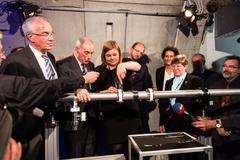URL: https://www.desy.de/news/news_search/index_eng.html
Breadcrumb Navigation
DESY News: Commissioning of the world’s largest X-ray laser begins
News
News from the DESY research centre
Commissioning of the world’s largest X-ray laser begins
The world's largest X-ray laser European XFEL, an international research facility with eleven European member countries, has begun the commissioning of the 3.4-km long underground complex. Around 350 guests from politics, administration, the diplomatic corps, scientists from around the world, and employees of European XFEL and its closest partner institute DESY celebrated this big milestone today on the new research facility’s campus in Schenefeld in the metropolitan area of Hamburg, Germany. In the underground tunnel near the facility’s experiment hall, representatives of the partner countries mounted an approximately two-metre-long beamline tube, as a symbolic act of installing one of the final still-missing pieces of the X-ray laser. DESY is the main shareholder of the European XFEL and led the consortium that built the linear accelerator.

The Polish Vice Minister for Science and Education, Dr. Piotr Dardziński, said: “This is an important day for advancement of science. Closing of construction and starting of commissioning of the European XFEL is great news for many researchers in Europe and beyond. Eleven countries jointly invested over 1 billion euro to build this state-of-the-art facility. I am convinced that very good cooperation during construction phase of the European XFEL can be extended to the operation of the facility.”
Katharina Fegebank, Hamburg’s Second Mayor and Senator for Education, Research, and Equality: “We have been waiting for this day: The European XFEL is heading into its test phase. With the start of user operation in summer 2017, the research facility will elevate the Hamburg metropolitan area to the highest order of research with free-electron lasers. The ultraintense X-ray flashes of the European XFEL will make new views of chemical and biological processes possible. That brings hope for the development of new medicines and materials. And that means new products, new job opportunities, and growth and prosperity. Those are good perspectives for science and society!”
Ambassador Bruno H. Moor, State Secretariat for Education, Research and Innovation SERI, Switzerland, said: “With European XFEL and SwissFEL, two out of the five world-class research infrastructures of that kind will be located in Europe. They will for sure stand in a relation of complementarity, while competing to deliver the best possible experimental conditions to scientists from Europe and beyond. These infrastructures shall contribute to fostering the European leadership in all scientific fields relying on free electron lasers.”
Dr. Beatrix Vierkorn-Rudolph, from the German Federal Ministry for Education and Research, responsible for Large Facilities and Basic Research: “Excellent basic research is the basis for innovation and the prosperity of tomorrow. The Federal Ministry for Education and Research, together with the states of Hamburg and Schleswig-Holstein, has financed 58% of the European XFEL construction. The commissioning marks the beginning of our investment bearing fruit: We are very much looking forward to the first results from the world’s most powerful X-ray laser!”
Prof. Martin Meedom Nielsen, Chairman of the European XFEL Council: “All the member states are very happy about the great achievements that have brought us to where the commissioning of a world leading facility for X-ray science is about to start. In a way, this is an incredible success, because the complexity of the project has often required solutions to technical challenges beyond the state-of-the-art. I would like to express my sincere appreciation to the XFEL management and staff and to the Accelerator Consortium for their dedication and hard work having made this possible. I am convinced that the scientific community shares in the enthusiasm about the European XFEL and is eagerly awaiting the opportunity for making the first experiments.”
Prof. Helmut Dosch, Chairman of the Board of Directors of DESY: “I congratulate the European XFEL Accelerator Consortium for this outstanding achievement. This big success was made possible through the enormous team spirit of the Accelerator Consortium, which had collaborated very closely to reach this high aim. I have the highest appreciation that this was accomplished on a tight budget.”
The Chairman of the European XFEL Management Board, Prof. Massimo Altarelli, said: “Thanks to the very intense and highly competent work of the European XFEL staff, of the staff of the DESY accelerator division and of the partner laboratories, we are now ready to gradually switch on the whole facility, with the goal to start operation of the facility in the early part of 2017. I would like to thank all the people involved who are turning this long-standing dream of the science community into reality.”
In the coming weeks, DESY scientists, as well as those from an international consortium under their leadership who helped build the facility’s 1.7-km long superconducting electron accelerator, will cool the accelerator to the operating temperature of -271°C and bring it into operation. The accelerated electron bunches, which are expected to be generated early next year, will then enter the photon part of the facility, which was built by the European XFEL staff. The electrons will then be channelled into the X-ray–generating magnetic structures called undulators. The alternating magnetic poles will force the electron bunches to take a zigzagging “slalom” course over 210 m. Extremely bright and short X-ray flashes with laser-like properties will be generated in a self-amplifying process. Starting in summer 2017, external scientists from around the world will be able to use two out of the six initial planned scientific instruments for the intermediate term. The new research facility will then be officially opened in another international ceremony.
Further Information: www.xfel.eu



